#replace 1 portable system with another that can emulate
Explore tagged Tumblr posts
Text
after the instant hype deflation from learning about the ridiculous pricing for switch 2 games, ive finally decided to just go ahead and get a steam deck
#replace 1 portable system with another that can emulate#+ steam deck prob cheaper than upgrading my pc at this point#switch 2 making me so sad#eat absolute shit nintendo
2 notes
·
View notes
Text
Best Gaming Laptops
Best Budget Picks 2021
With regards to gaming, workstations are constantly viewed as the replacements of PCs as they are simpler to utilize a lot. That being said, assuming you need outstanding amongst other gaming PCs under 400, I have something intriguing for you. Best Gaming Laptops Under $400
Notwithstanding, I will not permit you to keep better standards from a PC under 400. You'd have the option to play some old AAA games from 2012 to 2015 effectively with a PC that costs two or three hundred bucks as it were.
In this way, presently coming towards the principle subject, I've arranged a rundown of top 10 best gaming workstations under 400 for you to settle on an insightful choice. Look through this rundown and head towards the audit area for better appraisal individually.
Top 10 Best Gaming Laptops Under 400 – Updated List 2021
1. Acer Aspire 5 – Best Gaming Laptop Under 400 out of 2021
2. ASUS VivoBook 15 – Thinnest Gaming Laptop Under 400
3. HP 14″ HD – With Windows 10 Operating System:
4. HP 14″ Touchscreen Laptop – Best Laptop for Minecraft Under $400
5. Most current 2020 HP – With tenth Gen Processor:
6. Lenovo Chromebook C330 – Best 2-in-1 Laptop Under $400
7. HP 2019 – With Ergonomic Keyboard
8. ASUS VivoBook L203MA – Ultra-Thin Gaming Laptop:
9. Lenovo 130S-11IGM – With Office 365:
10. 2019 Lenovo IdeaPad – With AMD A9 Processor:
Purchasing Guide: What to Expect from a $400 Gaming Laptop?
Much of the time Asked Questions
Top 10 Best Gaming Laptops Under 400 – Updated List 2021
# Laptop Name Processor RAM Price
1. Acer Aspire 5 AMD Ryzen 3 4GB DDR4
Check Price
2. ASUS VivoBook 15 Core i3, tenth gen. 8GB DDR4
Check Price
3. HP 14" HD AMD Ryzen 3 4GB DDR4
Check Price
4. HP 14" Touchscreen Laptop AMD Ryzen 3 8GB DDR4
Check Price
5. Newest 2020 HP Core i3, tenth gen. 4GB DDR4
Check Price
6. Lenovo Chromebook C330 MediaTek MT8173C 4GB DDR3
Check Price
7. HP 2019 AMD A9 4GB DDR4
Check Price
8. ASUS VivoBook L203MA Intel Celeron N4000 4GB DDR4
Check Price
9. Lenovo 130S-11IGM Intel Celeron N4000 4GB DDR4
Check Price
10. 2019 Lenovo IdeaPad AMD A9 4GB DDR4
1. Acer Aspire 5 – Best Gaming Laptop Under 400 in 2021
Acer Aspire 5
Acer Aspire 5 is without any doubt, the best gaming machine available in the market with an extremely affordable budget. All low-budget gamers must pay high regard to the brand as it has made gaming easier for them. That being said, I bought this laptop a year ago as I was already low on budget. Up till now, investing in it was one of the best decisions I’ve had ever made. The laptop, up till now is running at an optimal performance that I didn’t expect at all. Well, the first expressions are simple, smooth, and sleek. This laptop isn’t bulky or weighty at all. It’s a perfect portable gaming machine for the gamers who’ve got no more than 400 bucks to spend. Long story short, Acer Aspire 5 should be the ultimate winner whenever we talk about the best budget gaming laptops.
Now coming towards some serious discussion, Acer gaming laptop has been powered by an AMD Ryzen 3 processor which is fast enough to run heavy applications. It can also load the games faster than other typical laptops.
In addition to that, what I liked the most about this laptop is the upgradation of random access memory. The presence of a 4GB DDR4 ram is, thus more than enough to help you in multitasking. You can easily play games, run songs in background, or do any other activity without any problem.
The discussion doesn’t end here. Acer Aspire 5 is also equipped with updated AMD Radeon 3 graphics to ensure a smoother gaming experience. Games like PUBGM Emulator, GTA IV, and Need For Speed – The RUN are, thus easy playable on medium to high settings.
Last but not the least, there is no compromise on the overall durability of the laptop. I’ve been using it for one year and so far the laptop is working just perfect for me. That’s one of the main reasons I’ve kept this laptop in high regard.
2. ASUS VivoBook 15 – Thinnest Gaming Laptop Under 400
Asus Vivobook 15
Asus is a brand that is famous for introducing thin, sleek, and slim computing machines. That being said, some of its laptops even beat the class of an Apple MacBook in an affordable budget. Well, the laptop we are about to discuss goes by the name as VivoBook 15 and it’s the thinnest laptop available in 2021 within a 400$ budget. Yeah, you heard it right. With exceptional gaming and multitasking capabilities, the overall design of this laptop is extra thin and that’s the beauty of Asus VivoBook 15. Apart from that, you’d find an updated CPU plus GPU combination along with an ample amount of memory and storage at the same time. This laptop is, thus perfect from every angle regardless of the price it has got.
Talking about some main features, one of the best gaming laptops under 400 is equipped with a powerful 10th gen. core i3 processor. This processor is responsible for maintaining the overall performance of the laptop. You can, thus enjoy a fast and smooth gaming experience at the same time.
On the other hand, what intrigued me the most regarding VivoBook 15 is that it has a large 15.6″ full HD 1080p display. It enhances the gaming performance and helps you to enjoy vivid graphics of games at the same time.
The presence of Intel UHD graphics card along with an 8GB DDR4 memory ensures a smooth and fast gaming experience. Games like Minecraft, Fortnite, PUBGM, and Counter Strike Global Offensive can easily be played on this laptop.
Last but not the least, Asus offers a one-year damage protection guarantee with this laptop. So, in case the laptop gets damaged within a year, you can claim the guarantee from the official customer support easily.
3. HP 14″ HD – With Windows 10 Operating System:
HP 14-Inch
You’d see many best budget gaming laptops from HP here in this article because HP is the only brand that seems to be prioritizing the needs of beginner gamers. In this regard, this laptop from HP is just a perfect option for someone who wants to start gaming from scratch. As far as I’m concerned, it has got an ample amount of qualities to run many AAA titles on medium to high settings without causing any issue. On the other hand, the design and construction is also on par with other laptop brands such as Acer and Asus. As for the price, HP gaming laptop is available in no more than 400 bucks. It’s a complete bargain for a beginner or low-budget gamers respectively.
First things first, the best budget laptop under 400 comes with Windows 10 operating system. Keep in mind that this OS is perfect for running all latest games without causing any issue.
On the other hand, the presence of AMD Ryzen 3 processor also spice up the things pretty much well for beginner games. It enhances the overall performance and reduces the loading time for heavy games at the same time.
The combination of 4GB DDR4 ram along with a 128GB super-fast SSD ensures a smooth and responsive gaming experience. That being said, the laptop can easily play games like GTA Vice City, Project IGI, and Minecraft on medium to high settings. Games like NFS – The Run, and Counter Strike are also playable.
Lastly, a 14″ full HD display makes it easier for you to focus on the game you are playing. It can easily render the graphics smoothly to allow you to play games without any glitches.
4. HP 14″ Touchscreen Laptop – Best Laptop for Minecraft Under $400
HP 14-Inch Touchscreen
Another laptop from HP that is getting extremely popular among the gaming community comes with a touchscreen interface. Sounds interesting right? Well, it is for sure. The brand new laptop comes with all latest specifications to ensure a smooth, fast, and lag-free gaming experience. Apart from that, the overall shape and body is lightweight and portable enough to be carried around from one place to another. Games like Minecraft, PUBGM, and GTA IV can easily be played on this laptop with a better fps rate. That’s one of the reasons many low-budget gamers are praising this ultimate gaming beast from HP.
As far as the main specs are concerned, one of the best gaming laptops under 400 is powered by Vega 3 graphics card from AMD. The graphics card is powerful enough to play Minecraft and other free world games on high settings.
Besides, the backing of AMD Ryzen 3 processor is just exceptional. It enhances the overall performance and reduces the loading time especially when you are playing heavier games.
Last but not the least, what matters the most about this gaming laptop is that it comes with a touchscreen interface. That said, the touchscreen is responsive enough to enjoy multitasking and other activities at the same time.
5. Newest 2020 HP – With 10th Gen Processor:
Newest 2020 HP
The newest 2020 laptop has been introduced in the market by adding some advanced features and specs to it within an affordable budget. This gaming laptop under 400 has got a slim and sleek design. It’s portable enough to be carried around from one place to another easily. Apart from that, what I like the most about this laptop is that it remains responsive even if you are using it for a long time. There won’t be any lagging or glitch issues as far as you are taking good care of it. So, long story short, it’s yet another budget option available that can be considered if you are not content with the laptops I’ve mentioned above.
Breaking down the main qualities, one of the best HP gaming laptops comes with a powerful 10th gen. core i3 processor. It speeds up the performance and efficiency of the laptop so that it can run games smoothly.
Besides, the presence of 4GB DDR4 memory along with a 128GB SSD helps you to utilize this laptop in multitasking. You can enjoy playing games, surfing internet, or playing songs in the background with this computing machine conveniently.
Lastly, the presence of a genuine Windows 10 operating system makes it easier for gamers to play new games on low to medium settings easily. You’d surely enjoy the likes of Minecraft, GTA IV, Need For Speed – Rivals on this laptop with an average fps rate of 40.
6. Lenovo Chromebook C330 – Best 2-in-1 Laptop Under $400
Lenovo Chromebook C330
Want to play games on an extremely compact gadget within an affordable budget? This demand of yours is met by none other than Lenovo C300 that portrays a convertible design. Yeah, you heard it right. One of the best 2-in-1 laptops under $400 can be utilized for playing games such as GTA Vice City and Project IGI along with NFS-Underground. Other than that, what I liked the most about this laptop is that it can easily be carried around from one place to another without any worries. All in all, it’s a perfect option for those gaming freaks who want to play games all day long even if they are on the move.
Talking of the operating system first, this compact gaming laptop comes with Chrome operating system. Although the features that this OS offers are limited, it’s comparatively easier to use and access.
In addition to that, the laptop comes with convertible design. You can disassemble it to make the laptop, a full-fledged tablet. Mind you that the touch interface is extremely responsive to ensure a perfect surfing experience.
Finally, the integrated graphics card from Intel along with a super fast processor and 4GB DDR3 memory allows a smooth and responsive gaming experience. It’s thus a perfect option for students who want to play games in their extra time.
7. HP 2019 – With Ergonomic Keyboard
HP 14-Inch Laptop
Another gaming laptop from HP that is already gaining the attention of amateur gamers is HP 2019. This model comes with some updated features and specs to ensure a fast and smooth gaming experience. Besides, the reason I love it is that it comes with an ergonomic keyboard. It was easier for me to use the keys while playing FPS games like PUBGM or Minecraft. Regardless of that, one of the most affordable laptops is compact and portable enough to be carried around from one place to another easily. That’s one of the reasons many gamers are loving it.
First things first, the best gaming laptop has been powered by AMD A9 processor which is equivalent to an Intel Core i5 processor easily. You can, thus play multiple games on the laptop without any glitches or lagging issues.
Lastly, the laptop from HP comes with a 4GB DDR4 memory. Along with that it also offers an ample amount of storage in the form of 128GB SSD. You can, thus utilize the storage to download and install large game files without any worries.
8. ASUS VivoBook L203MA – Ultra-Thin Gaming Laptop:
ASUS VivoBook L203MA
Another masterpiece from Asus in the form of VivoBook L203MA is available for sale in 2021 at an extremely reasonable rate. Yeah, you got it right. This laptop will cost you no more than 300 bucks and I’m not even kidding at all. Talking of the specifications and features, they are a bit mediocre as the price is too low. However, even with these specs, you can play all games that were released between 2000 to 2015. So, it’s a bargain for the gamers and students who need a bit of enjoyment and entertainment whenever they get extra time.
The laptop, first of all, has been backed by a super fast Intel Celeron N4000 processor for better overall performance. In this way, you’d be able to play multiple games on it without any issues.
Apart from that, the availability of a full HD display along with 4GB DDR4 ram enhances the gaming experience to new bounds. That’s one of the reasons many gamers like this laptop.
9. Lenovo 130S-11IGM – With Office 365:
Lenovo 130S
The second last gaming laptop on our list is from Lenovo and the reason I’ve listed it is because I liked its ergonomics the most. To be honest, the laptop is too lightweight, portable, and compact at the same time. Besides, it offers some powerful specs and features at the same time. So, beginners who want to start gaming from scratch by playing some old-fashioned game can easily invest in getting this laptop without any other single thought.
Talking of the main features, the best gaming laptop under 400 comes with Intel Celeron processor for a fast gaming interface.
Besides, the backing of integrated Intel HD graphics card ensures a smooth gaming performance as you can play games like GTA Vice City and Project IGI on it easily.
10. 2019 Lenovo IdeaPad – With AMD A9 Processor:
2019 Newest Lenovo
We’ll be wrapping up our journey of best gaming laptops under 400 with 2019 Lenovo IdeaPad. This gaming laptop is powered up by a super fast AMD processor along with an integrated graphics card to ensure a smooth gaming experience. Besides, it also has a compact and portable body so that you can utilize it even if you are on the move.
Talking of the main features, the best cheap gaming laptop under 400 comes with an A9 AMD processor to ensure a super fast gaming performance.
On the other hand, the availability of 4GB DDR4 memory along with 128GB SSD also allows gamers to utilize this gaming machine for multitasking as well as for storing large gaming files.
3 notes
·
View notes
Text
Graphical breakthroughs in the Retroquad engine
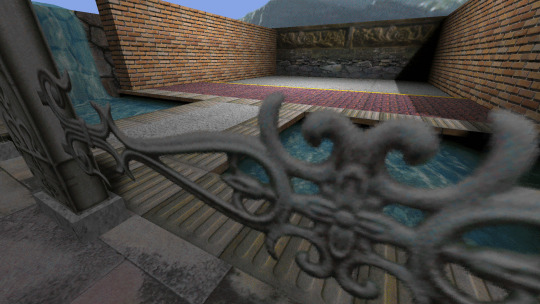
(Click here for full size image)
Luminance-Ordered Quadrivectorial Four-Way Quantization. AKA FWQ (Four-Way Quantization).
It's the key for the 8-bit indexed Quadricolor dithering used in the Retroquad engine. This article assumes that you already understand about dithering algorithms such as Floyd-Steinberg and the dithering filter used in the UT99 software renderer.
The Retroquad engine
From the readme file:
Retroquad is a game engine with a 3D software renderer that employs many color algorithms independently created by myself to solve the limitations of 8-bit indexed color systems, pushing their quality above the known possibilities of their current state of art. It is intended to be an engine with all the advantages of 8-bit indexed color 3D software rendering, but without the drawbacks of classic 8-bit color renderers.
Among its innovations are a proprietary quantization algorithm that compiles images in a special format that can be dithered in realtime in 3D space, eliminating the problem of texture pixelization that happens in all quantization algorithms that performs dithering in 2D space. This creates 8-bit color textures that looks incredibly more faithful to their truecolor counterparts and smoother at any distance, eliminating color restrictions for texture artists.
Other improvements already implemented include a smooth multi-step dithered and color-corrected lighting system that is combined with textures in realtime in a per-pixel fashion, a smooth dithered and color-corrected blending system used for multitextured glowmaps and translucent polygons, dithered interpolation of texture frame animations, dithered trilinear texturemapping, anisotropic texturemapping, a molten texturemapping technique that allows liquid textures to melt through all sides of any 3D object in a seamless fashion accross all of its edges, alphamasked textures with semitransparency, scrolling textures, multiplanar scrolling skies with horizon fading, dithered "soft depth" (for smooth shorelines, smooth scenery edges and "soft particle" style sprites), and procedurally generated particles with precomputed dithering.
Planned features for the renderer are dithered colored lighting using a fast 8-bit indexed color pipeline, edge antialiasing using an extremely fast preprocessing technique, dithered fog, texture crossfading (for terrain "blending" and triplanar texturemapping), Unreal-style hybrid skyboxes with alphamasked backgrounds & dynamic skies, perspective correction on character models, and HD texture support on all other parts of the renderer (GUI, HUD, character models and 2D sprites).
Also, its rasterizer doesn't distinguish between my new 8-bit texture format and classic 8-bit textures — both kinds of textures are rendered through the same 8-bit data pipeline, making the code easier to maintain.
The whole engine is being coded in pure C with no usage of processor-specific extensions. Hardware requirements are exactly the same as in classic software-rendered WinQuake, except for more RAM. The lack of processor-specific extensions usage is purposeful, to ensure that this engine remains highly portable and as hardware-independent as possible. Another goal was to remove and replace as much of the old Quake code as possible, to make its code more lean, polished and easier to maintain, hopefully turning it into a completely original engine.
However, multi-core processing was also planned, to improve 1080p performance and hopefully allow for 4K rendering without sacrificing the core goals of the project.
When fully polished, Retroquad should be robust enough for becoming a viable platform for creating new commercial quality independent 3D games that can be very quickly ported to other operating systems, consoles, mobile, and all kinds of obscure hardware and independent hobbyst hardware projects where it would otherwise be technically unfeasible or financially expensive to port them (such as the multitude of Chinese handhelds whose usefulness is limited to emulating old gaming consoles and playing classic software-rendered retro games such as Duke Nukem 3D and Quake).
Another reason for this engine to remain as hardware-independent as possible is to ensure future-proofing for software preservation. Games created using this engine will be able to be easily emulated for many decades in the future, making sure that people will always be able to experience them properly, even if their source is inaccessible or lost.
And finally, the last main reason why Retroquad exists. Since the 90s, I've seen many game engines, graphics chips and software platforms come and go, every one of them becoming obsolete and incompatible over time. I was never able to afford keeping up with them, and my life was always so screwed up that any ambitious project such as a full commercial game would take many years to be completed. Software rendering is the only tech I could use that will surely not suffer from hardware & drivers deprecation, the only tech I can count on to keep developing something and take my time to battle with the depression, poverty, health issues and other roadblocks in life, knowing that when I come back to it, it will still be working. Retroquad was intended to be an engine for people struggling in life, an engine that even if life slows you down and you take decades to create a game, it will still work as intended.
The tech

(Dithering comparison | Click here for full size image)
In FWQ, each vector is unidimentional, containing the quantization of the (forward, backward) direction across a single axis (horizontal, vertical). Thus, four way.
The "four way" aspect means each way is unrelated to each other (unlike, let's say, a diagonal vector, which is bidimensionally related to both axes of a horizontal plane). And because of this, each way can be handled independently. The left way is the only one that diffuses error to the left, the up way is the only one that diffuses error upwards, and so on.

(FWQ cubemap skybox | Click here for full size image)
The unidimensional aspect of each quantization vector also allows the error diffusion to spread seamlessly across cubemaps. This is an unique feature that can't be achieved with any other error diffusion technique because the quantization errors of a cubemap must be spread accross 3 axes, instead of only 2. A cubemap has 3 axes and each cubemap axis has 2 quantization axes, but each cubemap axis shares only 1 quantization axis with each other cubemap axis. The final result is that the error diffusion in each side of the cubemap is an intertwined mix of the error diffusion of its four adjacent sides. For example, the texture of the back side of the cubemap will spread its horizontal error diffusion to the textures of the left side and of the right side, while its vertical error diffusion will be spread to the textures of the bottom side and of the up side, essentially "giftwrapping" the error diffusion across the whole cubemap.
While all this works well for generating image data that can be dithered per-pixel in a tridimensional projection, there's another dimension where it didn't look good: Time.
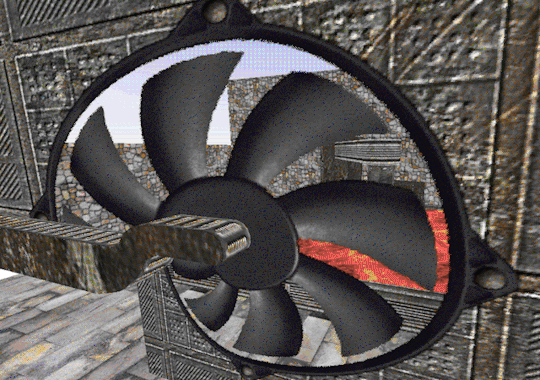
During animations (camera movement, animated texture frames, texture scrolling), the resulting image would look too noisy. This is because in error diffusion there's no way to control which texel will look brighter and which texel will look darker, unlike in ordered dithering. However, since four-way quantization outputs 4 color indexes for each texel, we can reorder the indexes of each texel by luminance, which will smooth out the brightness variance per pixel and eliminate most of the noise.
All that was described so far works well for textures that are close to the camera. It works very well when each texel is rendered to several pixels. However, it doesn't look so good for textures that are far away from the camera (with some texels being skipped from a pixel to another) because the error diffusion in them will also be skipped, resulting in an image that's not smooth enough.
Due to this, I've implemented an extra "error splitting" step in the error diffusion, to make the error diffusion be dilluted to both the next neighbor and the farthest next diagonal neighbor on each way, which makes the four-way quantization spread the error correction evenly accross all neighboring texels, effectively making the four-way quantization use an eight-way error diffusion. This looks good on submips, but in some cases it doesn't look so good on mipmap zero, because it reduces the strenght of the error diffusion. Also, because this error splitting technique violates the unrelational aspect of the four ways, it can't be used on cubemaps.
All of this four-way quantization data is stored in a special 8-bit indexed color format called "Quadricolor". In the Quadricolor format, the color of each texel is composed by 4 different subcolors, which means that each texel has 4 different subtexels. This is fundamentally different from direct-color formats such as 24-bit RGB, because while 24-bit RGB colors are divided into 3 different channel values (one for the red spectrum, one for the green spectrum and one for the blue spectrum), quadricolors are divided into 4 different subcolor indexes, with each subcolor index addressing a predefined color value (which in turn can be composed of 3 channel values, for a total of 12 channel values per Quadricolor). While smooth colors can be achieved in direct-color formats by simply modifying the value of each channel directly, the way to smooth out colors in the Quadricolor format is to find out 4 subcolors whose indexes points to palette entries with channel values that are balanced against the channel values of the palette entries of each other subcolor's index in a way that our brain can combine all of them to interpret the intended color.
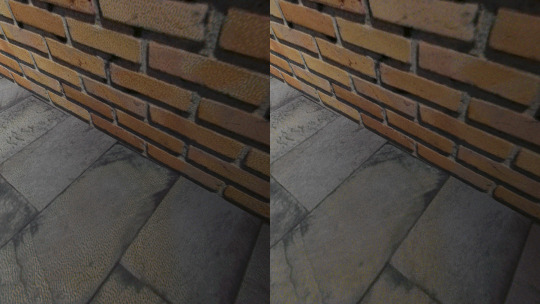
(Floyd-Steinberg dithered quantization with positional dithering on the left, FWQ with positional dithering on the right | Click here for full size image)
The nature of the Quadricolor format also means that to faithfully display a single quadricolor texel, at least 4 screen pixels are needed, one for each subcolor. This "one subcolor per pixel" aspect of the Quadricolor format allows the rendering engine to dither its subcolors into tileable screenspace patterns that allows each texel to be infinitely expanded without losing its intended color definition (unlike texelspace dithering techniques, whose intended colors lose definition by becoming too far apart when the texels are expanded).
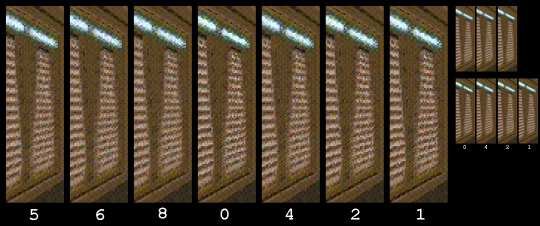
(Decontrast filter iterations | Click here for full size image)
However, when a Quadricolor texture is made of neighboring texels with quadricolors whose intended color spectrum is similar, only 1 pixel is needed for displaying each texel, with the on-screen Quadricolor being a cluster of 4 pixels from 4 different texels, with 1 different subcolor from each texel's quadricolor. This means that a Quadricolor texture can be displayed in native resolution with no significant loss of fidelity. To improve the balance between the subcolors of the quadricolors of neighboring texels and ensure better color smoothness, a special "decontrast" filter was created in the texture compiler to proportionally reduce the contrast between the neighboring colors of the 24-bit RGB source image.
And finally, the Quadricolor format being composed of 4 color indexes also means that the rendering pipeline made for it is fully compatible with regular 8-bit indexed color textures, by simply reading all subcolor indexes from the same offset within the texel.
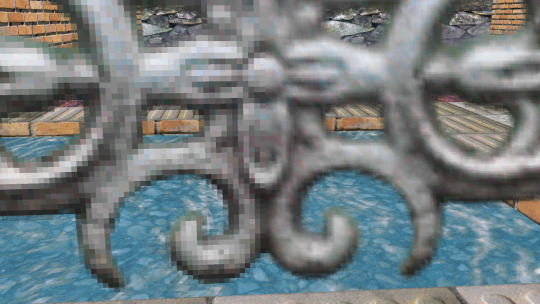
(FWQ 8-bit Quadricolor texture with semitransparent alphamasking; positional dithering disabled on the left side, and enabled on the right side | Click here for full size image)
Another advantage of the Quadricolor format is that it allows for creating semitransparent colormasked colors without an alpha channel. Due to being fragmented into 4 subcolor indexes, each Quadricolor can be fully opaque, fully transparent, or have 3 different stippled semitransparency levels (25%, 50%, 75%) depending on how many of its subcolors are transparent (0, 1, 2, 3 or 4).
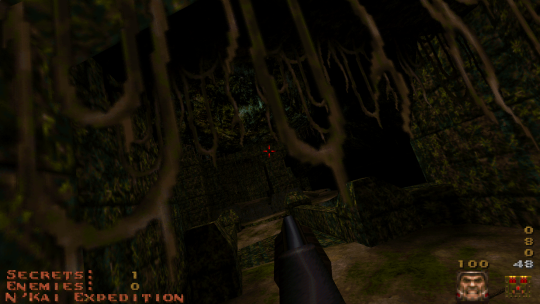
(Semitransparent Quadricolor alphamasking | Click here for full size image)

(Filtered hardware alphamasking comparison | Click here for full size image)
This gives smoother borders to colormasked textures, which is not possible in other color formats without an alpha channel.
Textures needs bidimensional RGB error diffusion between at least 4 neighboring colors, because they need all of their colors to be rendered at once (parallel output). But in color maps (for shading, blending, etc.), only a single intensity level is displayed at once (serial output), so they don't need error diffusion and can perform the error correction on the current color instead. The act of performing color correction on the current color is a technique that I call "error mirroring". While error diffusion gets the error value of the currently resulting color output and apply it to the next desired color input, error mirroring gets the error value of the currently resulting color output and apply it back to the currently desired color input, resulting in two subcolors of the same color with their error mirrored between them.
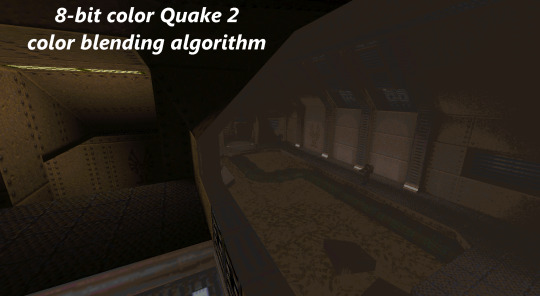
(Old blending | Click here for full size image)
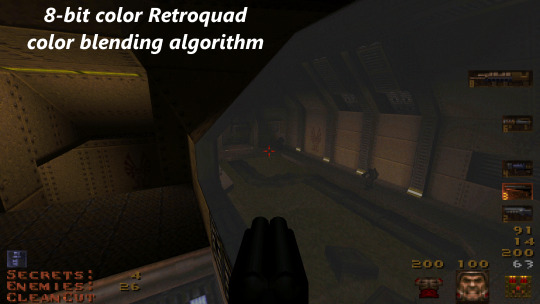
(New blending | Click here for full size image)
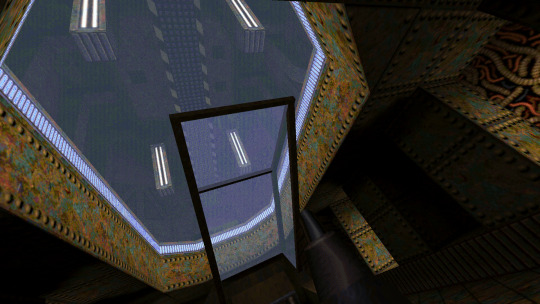
(Multi-layered blending | Click here for full size image)
For semitransparencies (including additive glowmaps), the Quadricolor format is used to display not just color correction, but also alpha correction. color maps are a combination of only two RGB colors accross a single serial alpha axis, so they only need two subcolors for error-mirrored RGB color correction, leaving the other two subcolors for alpha correction.

(Lighting comparison | Click here for full size image)
Lighting in Retroquad uses lightmaps, but it doesn't combine the lightmaps with the textures into surface image caches. Surface caches in Retroquad contains only lighting data, which is combined with the textures per pixel in realtime, and because of this they're called "surface lighting caches." This allows the surface cache UV coordinates to be dithered using different offsets, which makes each lixel (lighting pixel) to be spread accros multiple texels (texture pixels), smoothing out the final image better.
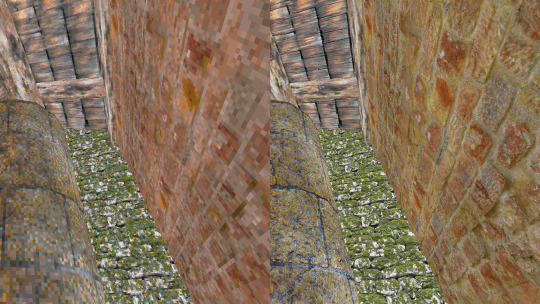
(HD texturing comparison | Click here for full size image)
It also allows the engine to support several more features such as HD textures and dynamically mapped texturing effects (scrolling textures, turbulence mapping, melt mapping, etc).
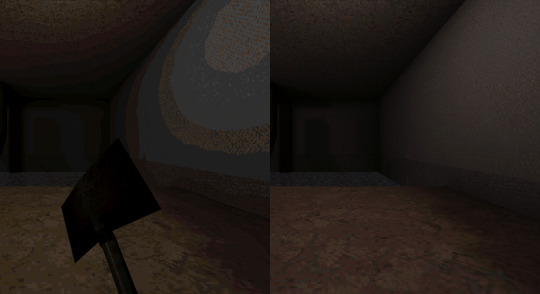
(Lighting comparison | Click here for full size image)
In the lighting, the Quadricolor format stores indexes of subcolors computed with color correction and brightness correction. However, these are only used in the color shading map. The surface lighting cache stores only the lighting level of each lixel, with 8-bit precision.
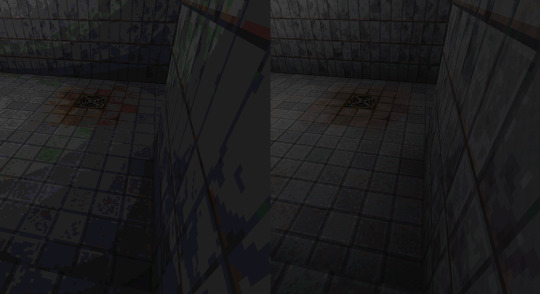
(Lighting comparison | Click here for full size image)
The lighting is dithered in three steps: surface lighting cache, lixel coordinates and color shading map. The lighting levels are dithered with 16-bit precision during the conversion from the lightmap to the 8-bit surface lighting cache, the per-pixel coordinates of the lixels in the surface lighting cache are dithered during the on-screen rasterization, and finally the lixel values are dithered with 2-bit precision to address the 6-bit levels of the color shading map.
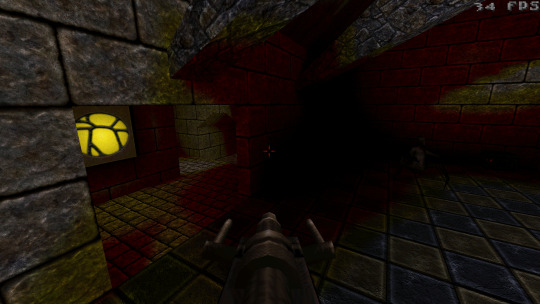
(Tinted light shading map experiment)
Colored lighting can be implemented through an additional 8-bit surface tinting cache map containing tinting information defined by 4 bits for 16 hues and 4 bits for 16 saturation levels, applied before the surface lighting cache. Lixel coordinates would be the same for both the surface lighting cache and for the surface tinting cache, so there would be no extra texturemapping cost for colored lighting. The main challenges would be to keep the banding between the 4-bit levels to a minimum, and to compute color correction, hue correction *and* saturation correction with an acceptable level of quality using only 4 subcolors for each quadricolor.
Color swapping and palette animations are possible to implement in Retroquad by applying a filtered palette during the quantization to restrict the source colors to the scope of the desired color range, and then using a color shading map with those color indexes swapped to the desired ones.

(Particles | Click here for full size image)
In Retroquad, a "particle" is a single colored point of a 3D visual effect image (smoke, stars, pellets, etc), just like a pixel is a single point of a 2D image. A single point doesn't have an individual meaning because each particle is not an image in itself, which is why particles should not be textured. Their visual meaning is given by their behavior and group structure, also known as "particle effect".
Despite particles being not textured, each particle is a point in 3D space, and therefore needs to represent depth by being drawn bigger when closer to the camera. The most appropriate shape for that is a circle, which is only affected by 3D camera position, not by 3D camera angles. Also, because each particle is just a single point in 3D space, and to keep its round shape consistent in any situation, its depth check is performed only once at their center pixel, which means that either the whole particle is visible, or it's completely occluded.
To be consistent with the smoothness of the dithering used in models and sprites, the particles must also be dithered. Also, one of my goals was to make sure the dithering didn't affect the perfectly symmetrical shape of the particles.
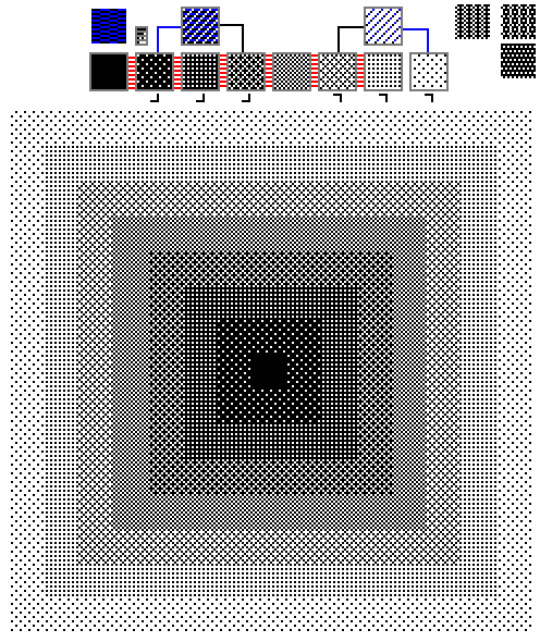
Since particles are not textured and have only a single color each, a different dithering optimization was implemented.
In a 4x4 opacity dithering matrix, each line has 4 possible levels of opacity (100%, 75%, 50% and 25% opaque), according to how many pixels are covered. Despite each line having 4 units of boolean values, the total amount of combinations is only 4 (instead of 16), because in the 50% opacity level the opaque pixels should always be apart, and all other possible variations of a same level of opacity can be represented by offsetting its index. By alternating between 2 different dithering opacity lines, 4x4 dithering patterns for 8 opacity levels can be achieved.
To define the area of each opacity level within the screenspace area of the particle, the shape of the particles was segmented into several halos, and each halo has a opacity level assigned to it. Afterwards, each line of the whole particle is scanned, and all line segments with identical line patterns between different halos are grouped into a maximum of 2 different line segments per pattern. This inter-halo pattern aggregation heavily optimizes the amount of iterations needed to draw the whole particle.
And finally, all lines of each pattern line are rasterized by individual functions featuring Duff device loops with some lines skipped to create holes according to the desired pattern. This makes dithered particles extremely fast to draw, faster than non-dithered particles, because instead of performing per-pixel verifications, it just executes less code. This, combined with the single-pixel depth check and all of the procedural steps being precomputed, allows the engine to render thousands of particles with no significant impact on performance.
Final words, and engine release

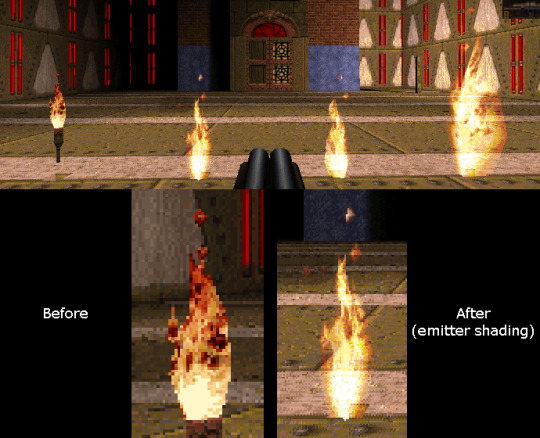
There are other graphical advancements in Retroquad such as soft depth, melt mapping and multiplanar scrolling skydome with horizon fading. Also, there are many more in-depth details that could be written about what's been revealed in this article so far. However, I'm not in a good condition to write about everything right now.
Retroquad is still far from what I envisioned. Originally, the plan was to release it once at least the BSP renderer had been completely replaced and the bugs were ironed out. It's saddening to know that my vision for it won't be fulfilled, but I don't want it to be completely lost either, so I'm releasing Retroquad as is.
Since last year I lost almost everything in my life. And almost lost my family. We are going to lose our house because I need to sell it to put food on the table, and the water will be cut soon because I've been wrongly blamed in a lawsuit. The future is grim and dedicating spare time to continue doing graphics research & development is not possible anymore.
The Retroquad 0.1.0 release is here: download.
I pride myself in having developed my tech without external help. But that doesn't matter anymore. I need to help my family, and have no means to do so.
If you're grateful for this release, or simply willing to help, I have created a donation campaign here.
6 notes
·
View notes
Text
The Best Portable Retro Gaming Console for Under $100: Evercade
Evercade Starter Pack
8.00 / 10
Read Reviews
Read More Reviews
Read More Reviews
Read More Reviews
Read More Reviews
Read More Reviews
Read More Reviews
Read More Reviews
Read More Reviews
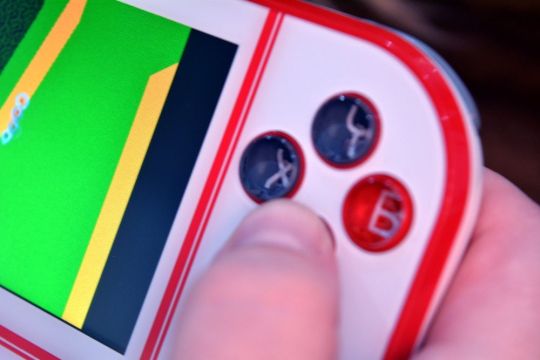
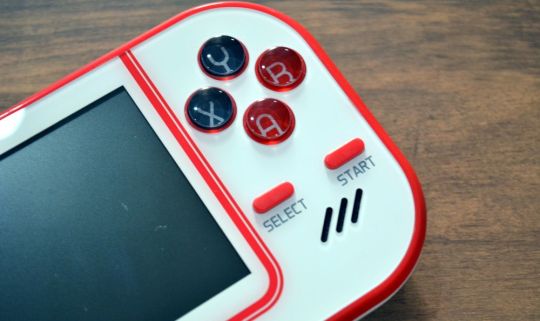
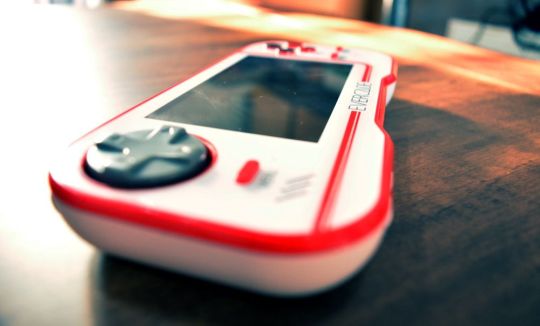
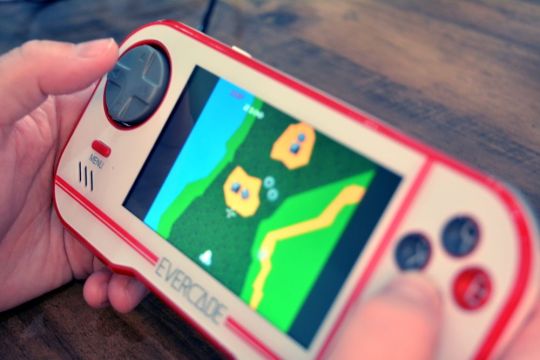
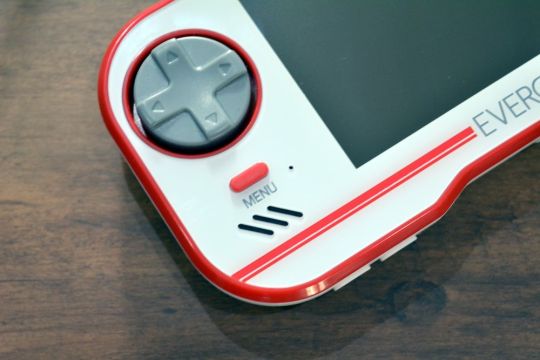
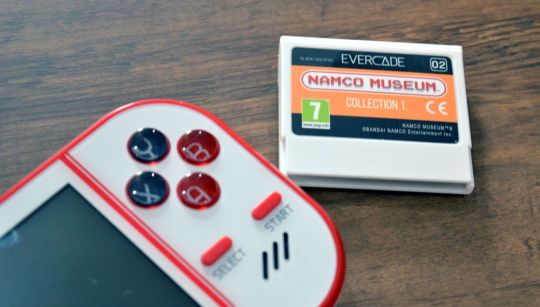
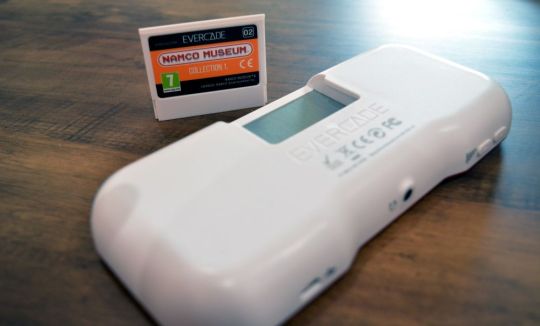
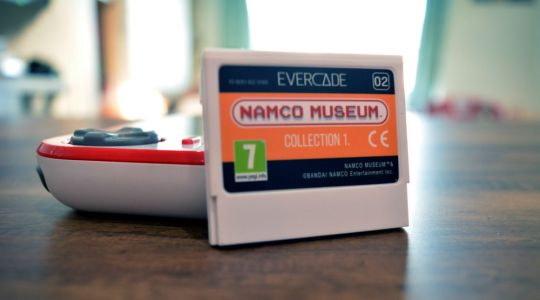
See on amazon
It looks good, feels good, and the curated games collections are good. Evercade evokes a bygone era of gaming in a way that simply shouldn't work in an age of digital downloads and streaming.
Key Features
HDMI-out
Retro gaming cartridges
Comfortable design
Save states
Specifications
Screen Dimensions: 4.3-inch
Storage: Cartridges
Portable: Yes
Battery: 2000mAh
Multiplayer Support: No
Connectivity: Mini HDMI, micro-USB
Brand: Evercade
Pros
Charges fast
Reliable controls
Cons
No console-to-console multiplayer
HDMI-out feels like an afterthought
Buy This Product

Evercade Starter Pack amazon
Shop
// Bottom var galleryThumbs1 = new Swiper('.gallery-thumbs-1', { spaceBetween: 10, slidesPerView: 10, freeMode: true, watchSlidesVisibility: true, watchSlidesProgress: true, centerInsufficientSlides: true, allowTouchMove: false, preventClicks: false, breakpoints: { 1024: { slidesPerView: 6, } }, }); // Top var galleryTop1 = new Swiper('.gallery-top-1', { spaceBetween: 10, allowTouchMove: false, loop: true, preventClicks: false, breakpoints: { 1024: { allowTouchMove: true, } }, navigation: { nextEl: '.swiper-button-next', prevEl: '.swiper-button-prev', }, thumbs: { swiper: galleryThumbs1 } });
Retro gaming consoles and classic system revivals are gaining in popularity. I've tried a bunch of retro gaming systems over past few years, from revived Commodore 64s to a Raspberry Pi Zero-powered Gameboy. They're all good, but have specific flaws---so how does the Evercade measure up?
If you're looking for a device that will play classic games from well-known publishers, and is small enough to fit in your pocket, consider the Evercade. Boasting a striking design, sharp display, responsive controls, and HDMI out, it's available with a choice of over 120 games at the time of writing.
What Is an Evercade?
Manufactured by UK company Blaze Entertainment, the Evercade is a handheld retro games console built to a high standard.
At first glance it could easily be an old handheld LCD gaming device from the 1980s, a period from which the console clearly takes many of its design cues. But there is far more to this device than looking the part.

Evercade isn't just a console---it's a platform, too. A range of games are available, packaged in groups by publisher name, around 10 to a cartridge. This differs depending on the generation of game, however, as older games require less storage space.
For example, the Atari cartridges feature double this amount, as the games were designed for systems almost 40 years ago. Conversely, the Interplay Collection 1 has just six 16-bit era games.
Game progress can be saved to the Evercade, too, giving you the advantage of being able to complete classic arcade titles in your own time, rather than sweating it out all in one go.
In the Evercade Box
Two Evercade options are available: The Starter Pack, and the Premium Pack. These are identical in terms of hardware but vary in the number of games included. While the Premium Pack features three cartridges (each holding multiple titles, more on that later), the Starter Pack has one.

In the box, you'll find the Evercade itself, a USB charge cable, and a cartridge box. Charging the Evercade first is recommended, but you'll need to provide your own wall charger with a suitable USB port.
Also included is a Quick Start Guide which will walk you through the basic setup and cover most troubleshooting issues.
The Evercade Console in Detail
Picking up the Evercade for the first time, you'll notice how comfortable it feels to hold. Its curved rear corners fit into the palms of your hands; the notch along the bottom makes a comfortable home for your pinkies.
Featuring a classic white and red livery, the console sports a 4.3-inch LCD. To the left of this is a responsive Sega-style D-pad, menu button, and speaker; on the right, ABXY buttons, select and start functions, and another speaker.

The top of the Evercade has left and right shoulder/trigger buttons, a power switch, and mini-HDMI output. Are the shoulder buttons oversensitive? Probably, but with a modicum of care it's easy enough to avoid touching them.
At the bottom, there's the volume control, audio out for headphones, and the micro-USB charging port.
Around the back of the console is the cartridge port. There is no eject feature, so you need to be careful inserting and removing carts to avoid damage.
Evercade Console Device Specification
Weighing 214g (cartridges weight around 15g) and measuring 182x82x21mm the Evercade features a 4.3-inch LCD display at 480x272 pixel resolution.

A 1.2GHz Cortex-A7 CPU is the system's workhorse, while the OS is Linux, which you won't see. The only user interface you'll see is the game carousel and menu system (more on that below). Evercade is designed to play games released on the Atari 2600, 7800, and Lynx, the NES, SNES, Gameboy Advance (GBA), and Sega Genesis/Mega Drive.
Powering the console is a 2,000-mAh rechargeable battery, which apparently cannot be replaced. This should not be completely discharged or left on charge for more than 12 hours. HDMI video output is 720p, and beyond this and the micro-USB port, there are no connectivity options.
Insert Cartridge, Play Games
Unsurprisingly, most Evercade titles are classics from Atari, Dataeast, Namco, etc. Many big-name arcade and console games from the 80s are available. Too many are available to list here, but if you opt for the Evercade Premium Pack you can expect:
Atari Volume 1: Centipede, Adventure, Alien Brigade, Asteroids, Missile Command, Crystal Castles, Food Fight, Desert Falcon, Motor Psycho, Canyon Bomber, Gravitar, Double Dunk, Ninja Golf, Steeplechase, Night Driver, Tempest, Video Pinpall, Aquaventure, Yars' Return, and Swordquest.

Interplay Volume 1: Clay Fighter, Earthworm Jim, Battle Chess, Boogerman, Incantation, and Titan.
Dataeast Volume 1: Bad Dudes, Burger Time, Midnight Resistance, Side Pocket, Karate Champ, Joe & Mac 2 Lost in the Tropics, Fighter's History, Two Crude Dudes, Magical Drop II, and Burnin' Rubber.
Each of these cartridges has a Volume 2 set for launch in late 2020 or early 2021. These are joined by other bundles, games released initially on the Atari Lynx, Jaleco systems, plus games from the Oliver Twins, Piko, Technos, Mega Cat, and even a collection of Worms titles.
The Evercade Starter pack, meanwhile, features just a single cartridge. Our review pack shipped with the Namco Museum Collection 1, with Galaxian, Pac-Man, Xevious, Mappy, Dig Dug, Star Luster, Battle Cars, Metal Marines, Libble Rabble, Quad Challenge, and Mappy Kids.
However, some newer titles are also available. For example, the Xeno Crisis/Tanglewood Dual Game Cartridge features retro-styled games released in 2019 and 2018, respectively.
Earlier, I mentioned cartridge cases. Evercade is so keen to deliver the retro experience that all games are released on physical media, in clamshell packaging, complete with instruction manuals, and artwork. If you've embraced the vinyl revival, you'll understand this---if not, buy an Evercade and spend a few minutes of tactile interaction with the game packaging. Digital downloads are not welcome here.
Retro Gaming on the Evercade
Playing a game is a simple case of inserting a cartridge (with the console on or off) then using the D-pad to scroll through the options. When you find a game you like select A to launch it, then use the -Select and Start buttons to start playing. Instructions for each game are found in the cartridge's accompanying booklet.

Game progress can be stored on the Evercade. The Menu button launches a set of options in-game, allowing you to Save State or Load State. There is also a Setting option to change the screen ratio, as well as options to Quit or Return to Game.
Evercade settings are also available from the game selection carousel, again by pressing Menu. Here, ratio, brightness, and audio settings can be adjusted. Audio volume can be adjusted using the buttons on the bottom of the Evercade; to disable sound completely, use the Menu screen.
Playing Games With Evercade
As with any gaming system, you don't quite know what you've got until the system boots up, the game loads, and you start to play.
What becomes quickly apparent is that these games are not running in a standard multi-purpose emulator. They're running as close to perfect as it is possible to get. All those hours spent playing games in an emulator and ignoring the obvious flaws will be forgotten after five minutes on an Evercade.
With a mini HDMI cable or adapter, the Evercade connects to a standard HDTV. The results are good, the 720p is clean and crisp, although the port isn't perhaps sturdy enough to handle a knock heavy enough to disconnect from the TV.
Evercade: Old Games, Modern Device
It looks good, feels good, and the curated games collections are good. Evercade evokes a bygone era of gaming in a way that simply shouldn't work in an age of digital downloads and streaming.

Not everything is perfect; some games are home system conversions rather than arcade originals; the Evercade is prone to collecting finger grease; playing on a TV requires a long cable with no support for an additional controller. There's a lack of multiplayer, too, and charging takes a while with micro-USB rather than the more modern USB-C.
But overall, the titles illustrate the depth of support for the Evercade from games publishers. But most importantly, the games play perfectly on the console. Forget glitching, stuttering performance, or inadequate, ill-thought-out controls. Sound is perfect, the environment is stable; everything is optimized for the perfect retro gaming experience---and it shows.
The Best Portable Retro Gaming Console for Under $100: Evercade published first on http://droneseco.tumblr.com/
0 notes
Text
The Vic 20, The Commodore 64, and a brief history of Commodore's 8-bit line

Photo from Wikipedia - (By Evan-Amos - Own work, Public Domain, https://commons.wikimedia.org/w/index.php?curid=17414881)
Commodore was one of those companies that were in the middle of the computer revolution. They were innovators in the industry, able to bring computers to the masses. They were the leaders in 8-bit computing. They controlled the home computer market through most of the 80's. That ended in the late 80's as the computer industry became more competitive.
The Brief History of Commodore's 8-Bit Computer Line (featuring their most notable models.
Commodore launched in 1954 as an electronics company in 1954. They started out making calculators and other home and business electronics. In the 1970's and 80's they participated in the computer revolution. Commodore's first computer design was the KIM-1 designed for MOS Technologies in 1976.
In 1977 the first Commodore branded computer was the PET/CBM range of systems. PET stands for the Personal Electronic Transactor. The line formed the basis for all Commodore's 8-bit line of computers. This line of computers used the MOS Technologies 6502 microprocessor, and had up to 32K of RAM. The PET of computers used Basic 1.0 as it's operating system. Software for the PET came on cassette and disks. This First generation of the PET cost $795 US due to the integrated display.
In 1981 Commodore released the lower priced Vic-20. A successor to the PET. It ran the same MOS 6502 and has 5K of RAM (expandable to 32K like the first gen PET). Unlike the PET the VIC 20 connects to a regular TV which saved cost in manufacturing. Software for the Vic-20 came on cassettes, disks, and ROM cartridges. Cassettes and disks required external drives. This is another way Commodore saved money on manufacturing costs. The VIC-20 uses Command Kernel and Basic 2.0 for the Operating System. The introductory price of the Vic-20 was $299.95.
Between the VIC-20 and the Commodore 64 there was the release of the Commodore CBM-II. The CBM-II came in 2 models. The P-series sold as the home model , and used a MOS 6509, The B-series came with the Intel 8088 or the Zilog Z80. The B-Series came with an integrated display. Both the P and B series computers came with Microsoft Basic 4.0 pre-installed.
The Commodore MAX is another computer released before the 64. It runs on a MOS 6510, and 2KB of RAM. The MAX has a better graphics system than the VIC-20 due to it's .5KB of dedicated video memory. It also has better sound. The MAX has limited IO. It only has a cartridge slot for software cartridges. The MAX released in Japan in 1982 and discontinued in 1982. The Max is a failure, and that is likely due to the simultaneous release of the more powerful Commodore 64. The MAX cost $200.
The Commodore 64 released in January 1982. It is the successor of the VIC-20. It used the MOS 6510 and the MOS 8500, and has 64KB RAM and a 20KB ROM for the OS. It used the KERNEL, Basic 2.0 and GEOS (Gem OS, GUI based OS) operating systems. The Commodore 64 was a significant leap from the 6502-based VIC-20. With the extra processing power and memory, and it's sub $600 price it ruled the low-end computer market in the 80's. Part of the success of the 64 comes from it's availability at local department stores like Sears. It made the 64 accessible to the masses. The Commodore 64 was also released in an educational model titled the Educator 64. It shipped with a display and the open source Otiki OS, and Microsoft Basic 2.0. The Commodore 64 was also released as a portable computer as the Commodore SX-64. It released as a portable suitcase computer with a built in Floppy Disk drive. The Commodore 64 sold from 1982 through 1994. There were some minor releases like the Commodore 64 game system. The Commodore 64 can use the software from the VIC-20 and the MAX. It can run software on cassettes, cartridges, and floppy disks.
The Commodore 16 was an entry level computer designed to replace the VIC-20. It was released in 1984 for around $80. The Commodore 116 is identical to the Commodore 16 made for the European market. These computers use the MOS 7501 (compatible with the 5602). These computers come with 16KB RAM and 32KB ROM. These computers come with Commodore basic 3.5 as the OS. These computers can use software on cassette and cartridges. The Commodore Plus 4 is an upgraded version of the Commodore 16. It has an upgraded 64KB RAM and 64KB ROM. It sold for $299 marketed at business users. The key feature of the Plus 4 is that it came preinstalled with an office suite.
The Commodore 128 is the last 8-bit computer made by Commodore. It was released in 1985 running the MOS 8502 with 128KB of RAM. The second version of the 128 also had a Zilog Z80 microprocessor. This allowed it to run the 64's software. The 128 is expandable to 640KB RAM with upgrades. It runs Commodore Basic 7.0 and Digital Research CP/M 3.0 operating system. The Commodore 128 is the successor to the Commodore 64 and VIC-20. The 128 can run cassettes, cartridges, and floppy disks.
In 1985 Commodore also released the Amiga computer system. Although the Amiga is not an 8-bit computer it is important system in computing history. The Amiga, like the Macintosh, uses a graphical user interface (GUI) and a mouse to navigate the system. The computer also had advanced video and audio processors. For media purposes it was more capable than the Mac for video editing and audio production. Post production of many television shows in the 90's were processed on the Amiga. The Amiga was also the beginning of the end for Commodore. Poor management, engineering problems, and competition from competitors put pressure on Commodore. With that came internal strife in the upper management and engineering teams. Commodore lost its market share and went bankrupt in 1994. The Amiga technology, sold to other manufacturers, never made a comeback. The Commodore name did make a comeback in 2010 as Commodore USA. They sold Intel PCs in classic Commodore computer cases like the Commodore 64. It ran Microsoft Windows and emulated the Commodore 64. They licensed the Amiga name and the AROS (the current version of the Amiga OS) in 2012, but they went bankrupt in 2013.
My experience with the Commodore VIC-20
My experience with the VIC-20 came from my Uncle. My Uncle loaned my family his computer to use during his move to another state in 1982. It was my family's first experience with a computer. I was 6 at the time and I remember having to load all the software using cassette tapes and cartridges. I started to learn about computer programming at that time. Adding abilities to the computer meant writing programs and entering programs from books. After using the VIC-20 for about a year we boxed it up and shipped it back to my Uncle.
My Experience with the Commodore 64
The Commodore 64 was also provided by my Uncle. We got it in 1983 for Christmas. For the most part it felt like the VIC-20. Unlike the VIC-20 we had access to software because of its availability at local Sears stores. At the time there were magazines available with shareware disks and programming examples. There were also hundreds of books available at the local library. We used the 64 until January 1986 when we replaced all our older computers with an Apple-IIGS.
Conclusion
In all honesty I don't remember much about the Commodore computers we owned. I remember that I learned basic programming on the VIC-20, and I learned software design on the 64. I remember the load times from cassette software, and the days of typing code to play clones of the classics. Those are very brief memories. The Commodore-64 holds a bit of nostalgia for me because it is where.
0 notes
Text
Lenovo IdeaPad Y550 Battery all-laptopbattery.com
Apple says the total service time will be three to five days, and there is no fee.“A small amount of gas is produced during the cycling of lithium-ion batteries, but normally it’s not large enough to cause any significant swelling,” says K.M. Abraham, one of the pioneers of the Li-ion battery and a professor at Northeastern University.But that can change if a component malfunctions. One way that can happen, he says, is if the battery’s management circuitry stops working properly. “Normally, a battery is charged and discharged to specific voltage limits, which is controlled by an electronic management system in the battery pack," he says. "If there’s a failure, now it is not controlling the voltage and then the battery can over-discharge and over-charge, producing gas.”
If there's enough gas, the pressure can make the plastic pouch where the battery is stored deform outward. However, Apple hasn't provided details on the malfunction involving MacBook Pro batteries. Apple says the MacBook Pro batteries don't amount to a “safety issue,” but Abraham advises consumers to take precautions, including immediately unplugging any affected laptop and isolating it from flammable material like a couch. Then take advantage of the replacement program. “If you don’t take care of it now, it could cause a serious problem,” Abraham says.Lithium-ion battery fires and explosions are rare, but they have occurred in recent years in hoverboards, in Samsung’s Galaxy Note7 smartphone, and in e-cigarette chargers. Just last month, a battery fire started in the cargo hold of a Delta airlines flight from Salt Lake City to Bozeman, Mont. Fortunately, it was detected and extinguished before the flight took off.
The Battery life of laptops degrades over time. Its usage, how often you charge it, how long you charge it, everything affects its life. It’s common to see its life getting shorter every month. While Windows 10 does show you an approximate battery life of the laptop, both remaining, and time to charge, over time the software may get confused because of uneven charge cycles.That’s why it is recommended to keep charging between the same percentage of battery left to ensure battery capacity, and life. In this post, we will talk about how you can manually calibrate Battery of Windows laptops to increase its life.Note: Sometimes, OEMs offer software that can help you do that. Do check with the driver software or OEM software on your Windows 10 laptop for the same.Calibrate Windows 10 laptop’s Battery 1] Open your laptop’s Power management settings in the Control Panel. Go to Settings > Power & sleep > Additional power settings > Change plan settings > Change advanced power settings.
Lenovo IdeaPad Y550 Battery
LENOVO IdeaPad U310 Battery
Lenovo IdeaPad U160 Battery
Lenovo IdeaPad U110 Battery
LENOVO IdeaPad S300 Battery
Lenovo IdeaPad S100 Battery
Lenovo IdeaPad S12 Battery
Lenovo IdeaPad S10-3 0647-29U Battery
Lenovo IdeaPad S9 Battery
Lenovo G575 Battery
lenovo G570 Battery
Lenovo G555 Battery
Lenovo G550 Battery
Lenovo G470 Battery
Lenovo BATHGT31L6 Battery
Lenovo B550 Battery
lenovo B470A Battery
Lenovo B460E Battery
Lenovo B460A Battery
ThinkPad X230i Battery
lenovo V570 Battery
Lenovo ThinkPad X61 Tablet PC Battery
Lenovo ThinkPad X61s Battery
Lenovo ThinkPad X60 Tablet PC Battery
Lenovo ThinkPad L420 Battery
You can also click on the Battery icon > Battery Settings and then follow from there.Battery-life trouble is one of the most vexing challenges for laptop users (not to mention those of us who see our iPhones drop from 20% to 1% in 5 minutes). Qualcomm and Microsoft have announced a new PC design that runs Windows 10S and uses Qualcomm’s 835 mobile processor which they claim will give users an average of 20 hours of battery life. In standby mode the battery can last as long as a week before needing a charge. The news came at the Qualcomm Snapdragon Summit in Maui, where Qualcomm, Microsoft, and major hardware partners such as Asus, HP, Lenovo, Xaomi, and Sprint shared their vision for what is dubbed the “Always Connected PC”.
This refers to a new kind of PC that can run all day (with the improved battery life) and stay constantly connected to the internet with the Qualcomm LTE modem inside, no matter where the user may roam.This new ultrathin laptop is based on the ARM processor architecture and runs Windows 10 in emulation mode. The Qualcomm 835 SnapDragon processor used in these laptops is fast enough to run Windows 10s or 10 Pro with very little latency.Microsoft worked hard to deliver a full version of its OS that works well with Qualcomm’s 835 Snapdragon processor. The last time it tried this with Windows RT, it failed to make its operating system run well on the ARM processor used in hardware. Consequently, the Windows PCs never got any serious attention in the marketplace.
What I find most interesting in the announcement is that the “always connected” quality is similar to what we have with smartphones today. The only difference is in the size and shape of the device. Microsoft and Qualcomm, along with their partners, believe that these new Always Connected PCs will usher in a new era of portable computing where battery life is a second thought and always being connected is the norm. ASUS CEO Jerry Shen announces ASUS NovaGo at SnapdragonTechnology Summit [Photo: courtesy of Qualcomm] As a power user and avid mobile computer fan, I very much like the idea of having an ultrathin laptop with all-day battery life. I’d love to leave home in the morning without even having to think about carrying a power cord with me. Since the arrival of the first laptops in the late 1980s, consumers have been calling for thinner, lighter, powerful laptops that also have long battery life. PC makers have responded with a host of laptop designs over the years, including “Netbooks,” and, more recently, 2-in-1’s in which the keyboard is detachable and the screen can double as a tablet. But the big problem with any of the current laptops is that at best, they can give users only up to 12-15 hours of battery life. And if you’re into streaming movies and playing games, battery life on even the newest laptops is pared down to not much more than seven to eight hours at best.
LENOVO ThinkPad Edge S430 Battery
Lenovo ThinkPad Edge E431 Battery
LENOVO ThinkPad Edge E420s Battery
Lenovo ThinkPad Edge E420 Battery
Lenovo IdeaPad Z580 Battery
Lenovo IdeaPad Z560 Battery
lenovo IdeaPad Z470 Battery
LENOVO IdeaPad Y580 Battery
Lenovo IdeaPad Y470 Battery
lenovo IdeaPad G560 Battery
Lenovo IdeaPad G470 Battery
Lenovo IdeaPad G430 Battery
Lenovo IdeaPad B570 Battery
Lenovo IdeaPad B560 Battery
Lenovo Ideapad B550 Battery
Lenovo 3000 G430 Battery
LENOVO ThinkPad Edge E531 Battery
LENOVO ThinkPad Edge E31 Battery
Lenovo ThinkPad E50 Battery
Lenovo ThinkPad E40 Battery
Lenovo G575L Battery
Lenovo G575G Battery
Lenovo G575E Battery
lenovo G570E Battery
Qualcomm and Microsoft believe they’ve finally addressed the battery problem in a meaningful way.And knowing my laptop would always be connected no matter where I am could change the way I use the device. The PC also supports Wi-Fi, but Wi-Fi is not always available where LTE is available almost everywhere in the US and most of the world.Qualcomm and Microsoft and their PC-maker partners, as well as the wireless carriers that provide the LTE, will have to work hard to get consumers to buy into their vision. They’ll have to make us believe that the Always Connected PC is a new form of personal computing.One possible deal breaker is the question of whether or not the new machines will run all the apps that consumers are accustomed to. Microsoft execs told me the Always Connected PCs can be upgraded from Windows 10S to Windows 10 Pro for free, so that they can run all Microsoft apps.
Another key question is how much the carriers will charge for the LTE data connection, when data usage is expected to be much higher than on a smartphone. The cost and hassle factor of buying a new service plan could turn some consumers away. The carriers are still working out the cost issue, and we won’t see the numbers and terms until the first machines ship next year.Cristiano Amon, executive vice president of Qualcomm Technologies and president of Qualcomm CDMA Technologies, says the PC makers will sell the Always Connected PCs through traditional retail stores, online, and in wireless carrier stores.The carriers tried this once before with Netbooks. They were arguably too early with the idea, and it flopped. But carriers have become good at selling smartphones with data plans, so this time might be different. Qualcomm and Microsoft officials believe that with proper training the carriers will become an important channel for always on Always Connected PCs.
Microsoft and Qualcomm did extensive research before they launched the Always Connected PC program, and say that they found high demand for it in the market. They and their partners plan to spend significant money promoting it in the new year.Qualcomm and Microsoft executives assured me that many PC makers, carriers, and software developers that will back the new laptop program in the new year. Qualcomm execs even hinted that we could also see Always Connected PCs from smartphone makers in the near future. Why are Qualcomm and Microsoft introducing a new type of mobile PC and a new carrier strategy now? Three reasons:The first is that both companies have watched with great interest how people have become dependent on their smartphones. They’ve also seen that many users want to have a device with a bigger screen and a keyboard to do more than you can on a smartphone.
0 notes
Text
Can’t Afford a New Computer Because of Software?
2018-05-02 11:38
Within the past couple months, several people have told me that---although they have computers that are old and behind the curve in performance,---they cannot afford a new computer because they will have to buy all the Microsoft programs like Word, Excel, Powerpoint, Outlook, and such, since they cannot be transferred legally (or practically) to a new computer, and that is hundreds of dollars of additional cost thus making it too expensive to upgrade.
Feeling 'locked-in' to expensive Micro$oft productivity suites in this era is simply unnecessary. I have been using open-source, free alternative programs since before I got back from Germany, having experimented with converting while in Germany but still using Windows, and ultimately switching away from Windows to Linux around 2011. But one does not have to leave Windows to use the open-source alternatives as most are available for Windows, Mac, and Linux, although I now much prefer Linux to Windows for a multiplicity of reasons. Germany is a place where even slight additional cost is a killer in everything of life---which is why you never hear music in stores or restaurants, because of the royalty fees that must be paid to play it. Most Germans I was acquainted with, turned to the alternative and free open-source programs more than a decade ago. I finally took their cue and tried them.
Thus, it has now been over 10 years that I have been using the free alternatives to Microsoft offerings. I can read other people's messages and documents and they can read mine. All these alternative programs can save documents in a Microsoft compatible format. I have even used the 'redlining' editing and correction features of the word processors, and sent corrected files back to the authors, who usually have no trouble opening and dealing with those modified documents.
If you're leery of leaving Microsoft, then just install the alternative programs on your current computer and try using them for a while. That is what I did over in Germany. They work, and do not require the hundreds of dollars M$ wants you to send them to activate their software which is nowadays preinstalled but disabled after a trial period on every computer you might buy.
When you use an Android phone, you are basically using Linux (a stripped down version), so if Android is your phone, you are already exposed to an alternative system. iPhones are Mac OS-oriented, so if that is your phone, you are using yet another alternative to Windows, too.
I am currently upgrading to a new computer---a big Dell 17-inch touchscreen laptop that Costco was selling for an extremely good price, and which has AMD video that is about the only video card that will work properly when editing video. I'm not going to say it is easy to install Linux as an operating system---one of the reasons computers are preinstalled these days, is because installing any operating system can be difficult, and both Apple and Microsoft have tried to eliminate the hassles encountered in using computers by preinstalling everything on the computer, so there are no hang-ups when you first turn a new computer on.
This is not the place to go into a detailed description of problems I encountered, but a little patience and willingness to try the different alternatives presented during installation has paid off. I am a guy who brings computers to their knees. Typically I run 3 desktops with email, calendar, daily calibre downloads for my Kindle (it functions to load my Kindle up with what are the equivalent of several daily newspapers), financial software tracking expenses, my Google Keep lists of grocery and to-do items, and general web browsing, all in desktop 1; the weather reporting tools and audio recording/editing for the daily weather reports I do for a community radio station in desktop 2; and radio automation software that runs 24/7 as an experiment in desktop 3, which feeds an MP3 server that sends the output of the automation to a LAN connection that I can access from anywhere in the house.
For the past 6 years, all of that has run on a small 13” notebook that is hooked into an external 27” monitor, keyboard, mouse, and professional speaker system. My estimate is that any computer more than 5 years old is by then ancient technology (the notebook does not even have Bluetooth, which is now completely ubiquitous), so I try to upgrade every 5 years. This change is actually overdue, and so are you if your computer is more than 5 years old. I especially liked the portability of the smallish 13” computer, but video editing is nearly impossible with its incapable nVidia video card---which is fine for gaming, but absolutely terrible for video editing. The 17” Dell came to my attention because of the AMD video card, and so I will have a much larger laptop for a while. Not really what I wanted, but a necessary improvement for the video editing.
Those I have discussed the alternative of using productivity suites other than Microsoft, are literally very scared to leave Microsoft. Again, I suggest just trying it on your current Windows computer first. Once I installed the alternative programs while over in Germany and began using them, I never went back to the Microsoft ones. Ever. Not even tempted.
Here is a list of all the programs I use regularly:
**Evolution (Linux only) - email/calendaring substitute for M$ Outlook
**LibreOffice (all OS platforms)- substitute for Microsoft Office with word processing, spreadsheet, Powerpoint compatible alternative, drawing program which I use as a replacement for the now defunct M$ Publisher and which imports old M$ Publisher files, and a math program for statistics people
**Firefox - web browser with the following add-ons: NoScript to prevent websites from reaching into your computer; AdBlock; Blacken to turn grey print solid black; One Tab, which allows saving tabs in a list when you have a bunch of tabs open; Video DownloadHelper which allows downloading video/audio files to your local computer. Before the Quantum release of Firefox, I also formerly used Tab Mix Plus, which allows a lot of useful customization of Firefox, and Down Them All, which came in handy for things like downloading 30 episodes of “Danger Man” without having to manually do those one at a time. Hopefully those add-ons will eventually be made compatible with Quantum and later versions of Firefox.
**GnuCash - financial program similar to Quicken, but capable of double-entry accounting
**calibre - a Kindle organizing, library, and downloading program which allows converting practically any document into a Kindle file, and will also unlock files you paid for that often only work on a Kindle reader when you may have a Kobo or Nook reader---or in the other direction if you bought a book that only works on Kobo or Nook. Additionally, I download several news sources daily, including BBC News, Washington Post, local TV news station feed, and several economic or industry blogs and newsletters related to my field that I can then read anywhere on my Kindle.
**Gimp - image editor similar to Photoshop, only far more flexible
**Xsane (Linux only) - a program that operates scanners
**Pidgin - a program similar to the old AOL Instant Messenger which can connect to many different messenger programs. With cellphone texting, I have not used Pidgin for years.
**Audacity - an audio recording and editing program
**Cinelerra CV (Linux only) - video editing program
**gPodder - an automatic podcast downloader program. I do not use gPodder since returning from Germany, where I commuted an hour each way to work on the train and listened to several news podcasts daily (primarily BBC). If I listen to podcasts now, it is in the car and from my cellphone using the Bluetooth connection.
**puddletag (Linux only) - a Linux metadata tagging program for audio files similar to MP3Tag in Windows
**Rivendell (Linux only) - the radio automation program with many modules for creating logs, automatically downloading and carting up programs, and managing the audio library of radio stations
**Jackd and JackCTL - a patch panel program for routing audio to and from various programs
**VLC - the most universal and versatile video and audio player for computers ever, devised and maintained by French developers plus very lightweight in size
**wxMP3val - an analyzer for MP3 files to find quality problems
**Spotify Player - for Linux
**WINE - a Windows emulator program which I use to run Exact Audio Copy, a CD ripping program, and IrfanView, an image display and manipulation program that only work in Windows
**R - a very deep and complex program for math people like my son and used by statistics people for manipulation and publishing of math stuff, which includes access to special characters used only by math folks
Maybe there are those who need other programs, but for my work, the above fulfills all of my particular needs. And in 7 years without Microsoft, I never miss it. In fact, with no regrets at all, I blew away all the Windows stuff that was preinstalled on the new Dell.
All new computers come with Windows, and---as you can see---almost every program above can be loaded into a Windows computer, negating the need to send Microsoft any further money at all. Try them on your old computer, then have no fear in going out and getting that new computer and saying, “bye, bye Micro$oft, I don’t need your pricey office suite anymore,” thus joining what I have done for well more than 7 years now.
0 notes
Text
Aorus X9
The Aorus X9 is out to pack as much power as possible into an ultra-thin gaming laptop. While the Razer Blade Pro and Alienware 17 R4 have proven desktop replacements can be ultra-thin without compromise, this 17-inch gaming laptop kicks things up another notch by packing in dual graphics cards.
By harnessing the power of two Nvidia GTX 1070s, the Aorus X9 is the most graphically capable gaming laptop we’ve tested to date. What’s more, this beast of a desktop replacement also features four fans for unbeatable cooling and RGB lighting on every side. We just wish the Aorus X9 would have come with a larger battery and better inputs.
Price and availability
Starting at the heady price of $3,199 or £3,099, the Aorus X9 follows in the tradition of desktop replacements that cost over three grand.
At this price bracket, the 17-inch laptop is equipped with the same Intel Core i7-7820HK processor and dual Nvidia GTX 1070 graphics cards as our review unit, but only has a QHD (2,560 x 1,440), 120Hz display and a 256GB SSD. It’s also worth mentioning that you’ll only find QHD-variants of the Aorus X9 in the UK, but not in Australia.
Our review unit as configured to the right rings up for $3,649 or AU$5,099, which is slightly more affordable than the $3,799 (£3,799, AU$5,899) Razer Blade Pro. However, the Aorus X9 is also significantly more expensive than an equally well-equipped Alienware 17 R4 priced at $3,049 (£2,907, AU$4,998.
Meanwhile, if users want to double up on their flash storage, the price of the Aorus X9 bumps up to $3,799 or AU$5,399.
Design
Unlike the demure styling of Aorus’s gaming laptops that we’ve become accustomed to, the X9 is as loud as can be with edgy design elements.
The Aorus X9 fully embraces the RGB lighting revolution with a completely customizable 16.7 million-color backlit keyboard and multiple light bars around the chassis. It’s quite the lightshow, and all the more impressive when you take a closer look at the three distinct LEDs illuminating the power button and the 11 LEDs built into the light bar just above that logo.
Unfortunately, you can’t really put the lighting to good use. The most functionality we get out of the 11 LED light bar is using it as a battery meter or a temperature gauge.
While there’s also a music mode that’s neat in that it turns the laptop’s entire lighting array into a visualizer, it requires the user to increase the laptop’s volume to at least 80%. What’s worse is this music mode only works through the speakers, which basically limits its use to when you’re home and alone – that is, unless you relish in being the most obnoxious person in the room.
We would have loved it if there were a way to tie the lighting into games, like Counter Strike Global Offensive, to let us know when to reload – or when our abilities were back in Overwatch. Razer has been ahead of the game in this regard, and you’ll find all of these keyboard lighting features on all of its laptops.
Lighting aside, the Aorus X9 features a very angular design with enough metal edges to make the Lamborghini it was modeled after jealous. It looks more garish than the stealthier designs of the Aorus X5 v6 and Aorus X7 v6, but it’s balanced by the matte black paint job.
Measuring in at the same 1.18-inches (2.99cm) thickness as the Alienware 17 R4, the Aorus X9 pushes the envelope of what’s possible in an ultra-thin form-factor with its SLI-graphics card setup. Still, the Razer Blade Pro edges out as the thinnest machine measuring 0.88 inches (2.24cm).
Twack keyboard and trackpad
We were ecstatic when we first heard that the Aorus X9 would feature a mechanical keyboard with an astonishing 2.5mm of key travel. However, we are disappointed in the lack of tactile feedback from the laptop’s Kailh brown keyboard switches.
While these Kalih switches are designed to emulate the tactile bump of Cherry’s corresponding MX Brown switches on a keyboard, they feel more like they just crumbles under pressure. Pressing any of the keys even slightly causes them to bottom out without any resistance at all.
At the very least, we can say the Aorus X9 has an extremely spacious keyboard with large physical keys and more than adequate spacing between each one. Despite the lifeless feel of the keyboard, there are no problems with responsiveness. There’s no delay between us hitting the ‘G’ key and chucking out a grenade or quickly moving out of the way of oncoming rockets while gaming.
Other gaming laptops, like the MSI GT75VR Titan and Razer Blade Pro, have proven mechanical keyboards on notebooks can be as good as desktop peripherals. We really would have rather preferred if the Aorus X9 keyboard had more bite to it.
Likewise, the Elantech trackpad on the Aorus X9 is nigh unusable. Simple point-to-point tracking between our finger and the cursor is aggravatingly sluggish. What’s more, no matter how much we increase the palm rejection setting, we’re still constantly activating the sensor while typing.
Some might be able to stomach the keyboard and actually find it more usable than us, but it’s almost a requirement to replace the lackluster trackpad with a gaming mouse.
Thanks to copious amounts of ventilation, the Aorus X9 keeps its cool and ensures all of its components are operating at their peak performance.
Above the keyboard, there are several mesh sections and eagle-shaped ventilation on the underside to help its four fans pull cool air from both the top and bottom of the laptop. Of course, with that many fans spinning up at the same time, this system gets loud. But, it’s still not nearly to the level of other ultra-thin laptops, like the MSI GS63VR Stealth Pro.
That said, we’ll take a bit of fan noise if it means we can avoid thermal throttling, which the Aorus X9 does beautifully. The 17-inch gaming laptop’s extensive network of heat pipes and aforementioned cooling system, we didn’t see a single drop in performance no matter how far or long we pushed the system.
Usually, our gaming benchmarks will turn out lower results with each successive run, and thus why we give you an average of three tests. However, the frame rates you see above were the result we got every time without any deviation whatsoever. It’s something we’ve never seen any laptop achieve before, and it’s a testament to the Aorus X9’s thermal design.
Thanks to its dual-Nvidia GTX 1070 GPUs, the Aorus X9 is the most graphically capable gaming laptop we’ve ever tested. This 17-inch gaming laptop flies in the face of our synthetic benchmarks, with Fire Strike scores soaring 2,000 to 5,000 points above that of the Nvidia GTX 1080-powered Alienware 17 R4 and Razer Blade Pro.
It’s no surprise that the Aorus X9 is the first gaming laptop to give us a steadily playable 4K gaming experience. We ran Shadow of War and The Evil Within 2 at Ultra HD and ultra-quality settings at an average 26 frames per seconds (fps) to 30fps, respectively. Thus far, rigs powered by a single Nvidia GTX 1080 have only been able to eke by at an average 20 to 25fps.
Although the Aorus X9 also shares the same processor as it rivals, the Alienware 17 R4 pulls ahead with slightly higher benchmark numbers. The Razer Blade Pro is the weakest in the bunch with the lowest performance numbers.
Sights and sounds
Thankfully, the Aorus X9 comes with a superb pair of speakers and a display, making gaming experiences as pleasurable to the eyes and ears as possible.
The 4K display is definitely the brighter highlight of the Aorus X9’s audio-visual package. The Pantone-certified display lives up to its classification, with perfect color tuning and excellent contrast. Likewise, the laptop’s stereo speakers offer decent sound separation and are loud enough to overcome the sound of the fans.
Battery life
At most, you should expect an hour of battery life out of the Aorus X9. As laughable as that might sound, it’s not a joke. Aorus’s flagship gaming laptop only lasted for 1 hour and 9 minutes on our video playback test, a mere minute longer than it performed on the PCMark 8 battery test.
Comparatively, the Alienware 17 R4 offers a better, but still not superb, 3 hours of battery life, and the Razer Blade Pro lasts the longest at four hours. Whether Aorus ran out of room for a larger battery or it just falters under the sheer weight of two high-end GPUs, you’ll definitely need to carry the power adapter for this 17-inch machine if you mean to take it outside.
We liked
The Aorus X9 is one of the most uncompromising and impressive ultra-thin gaming laptops on the market. It’s ability to pack in a second graphics card into a frame as thick as the Alienware 17 R4 is impressive on its own. Better yet, it puts all of that power into making it the most graphically capable gaming laptop we’ve ever tested.
We disliked
Having only a single hour of battery life disqualifies this desktop replacement from calling itself a gaming laptop. If you take it with you outside and can’t find a power outlet, you should expect to get an hour and a half of usage, and that’s if you’re strictly sticking to simple tasks, like word processing or web browsing.
We’re also not crazy about keyboard and trackpad – especially the trackpad. While the keyboard is good enough for gaming and quick strings of chat text, you’re going to want to keep a mouse connected to this laptop like it’s a part of it.
Final verdict
The Aorus X9 caters specifically to the most devout hardcore gamers who want to push all their graphical settings to the max, and this gaming laptop is beautifully engineered to do just that. SLI graphics cards in a gaming laptop is a real rarity these days, thanks to the greatly improved performance we’ve seen from Nvidia’s mobile Pascal architecture, and so this 17-incher is a unique outlier with its two GTX 1070’s. We also can’t help but be impressed by how the Aorus X9 is always ready and willing to run at max performance without fail.
If you’re looking for something more possibly portable with friendlier built-in inputs, the Alienware 17 R4 is the stronger choice here. That said, if you would rather have the most graphical power that can possibly fit into a gaming laptop, there’s nothing that can match the might of the Aorus X9.
Aorus X9
0 notes
Text
Shadowing and the Art of Task & Usability Analysis - Elicitation Technique #2
Shadowing - it sounds mysterious and a bit film noir, but shadowing is, basically, observing users in action as they perform their tasks. When used in conjunction with:
Task Analysis - breaking a task down into smaller actions and/or steps for observation/analysis
Human Factor Analysis - human behavior as it relates to products, services, environment, etc.
Usability Analysis - evaluating usability of an application, product, or service via user interaction
Shadowing becomes a powerful elicitation technique that can lead to user-centric designs that are clean, efficient, intuitive, and scalable.
Observation gives you firsthand knowledge of how a user completes a process/task or interacts with a product/application, given all the environmental factors around them. Basically, showing you what they do, how they've adapted, and what they don't do! This simple process of watching, interviewing, recording, and analyzing the outcomes can:
Identify issues, problems, and opportunities for improvement
Measure speed, task completion, responsiveness, performance, and user satisfaction
Assess environmental factors, hardware, and additional software/interface needs
Build a cohesive team by directly involving users in the design process
Lead to a deeper understanding of the users, tasks/processes, and product/application
Although shadowing can, also, be used to improve and/or update an existing process, today's blog will focus on its use to improve and/or replace an existing software application.
Get Ready
A little prep work prior to the observation sessions will ensure you have everything you need for the actual sessions, final analysis, and report/recommendations. Start with this quick list.
What to do:
Read the user-training manual, if available, so that you have an idea of how the system works.
Identify and ask for permission to observe different levels of users conducting the same task (e.g. the experienced user, the inexperienced user, the tech savvy, the not so tech savvy, etc.).
Note the identified users' titles and job responsibilities.
Send an email to the identified users letting them know that you will be conducting the sessions and what to expect. Focus on the system.
Determine what type of hardware the user has (e.g. how old is it, are they on different versions of software, does it need to be portable, touch-screen, type of internet connection, etc.). This information can also be obtained by conducting a survey (see the "Survey Says" article), and should be included in your final analysis.
Put the user at ease, be friendly, be empathetic, you are there to evaluate the system not them.
Be aware of the fact that observing someone may change the way they behave (e.g. people freak out a little when they are being watched, and may not behave naturally).
Look for patterns across the pool of users you observe.
Take notes...lots of notes...and diagram things like workflows, task, sub-tasks, etc.
Note any performance issues that occur and where in the workflow they occur (also note date and time of the occurrence).
What not to do:
Don't suggest possible solutions. If a user suggests a possible solution, note their suggestion, but redirect them to focus on the details of the problem.
Try not to interrupt the user too often, be patient, make a note and ask later.
Try to remain unbiased.
Don't interpret behavior without confirming (e.g. If a user rolls their eyes, ask why).
Don't get in the way!
The Observation Process - Show and Tell, Then Repeat
Elicitation techniques do not provide everything a business analyst needs in a single sitting, they need to be repeated multiple times (i.e. iterations) in order to capture the high level concepts and detail information. Since we are using shadowing/observation combined with several other techniques, we recommend the following process to get the most out of your sessions:
Who - Begin with the most experienced/knowledgeable user who can provide you with the most accurate information. If there is more than one user group/role involved, start with those involved in the beginning of the process and work your way to those involved in the end of the process.
What - Decide what it is that you want to learn from your observation (e.g. the overall user experience, usability of the application, task flow, etc.).
When - Determine if a task/process is affected by peak, normal, or slow hours during the day or if the task/process only happens during certain times of the day, week, etc. and then observe during those times. Limit each observation to 1-hour sessions.
Where - Environment plays a key role in observation and, ultimately, designs (e.g. banks operate differently than hospitals - even within hospitals patient information, for example, will be acquired, accessed and used differently by different roles/positions/departments). The design of the user interface and the delivery products used should reflect the user environment. Note the environment/working conditions and take photos if necessary.
How - For the first session have the user walk you through their tasks and interactions (focus on the positive path first). Don't interrupt them or their train of thought, unless they go completely off topic. Outline the process (graphic boxes of task flow, and supporting text such as Step 1, Step 2, etc.). In the second session (and if you're lucky, subsequent sessions) have the user repeat the tasks, including any alternate paths to completing the main tasks, and this time ask questions to clarify the process. You can create a checklist (from the next section - What to Look For...) to note usability issues, human behavior variations, etc.
What to Look For - 7 Areas of Observation
Here is a starter list of seven areas of observation that incorporates some high level principles of process, information, and technology design around the user experience (UX). A web designer/engineer would have a far more comprehensive approach, but these observations will provide you with the level of detail needed for your analysis and will help support your recommendations in your final report.
1. Security
Logins/Emulations - are views specific to the logged in user, and can a logged in user emulate another user in order to handle that user's workload?
Roles - Are views limited to roles within the system?
Access - Is access to data restricted based on role or business rule (is restriction limited to read only, update, etc.).
2. Performance
Speed/response issues (e.g. upload, download, page/list renderings, search, saving, updating, etc.).
Restrictions on file size or data processing.
System downtime and recovery issues.
3. Process
Workflow/Tasks
Is the application designed in such a way that it guides the users through their workflow/interactions or does the user need to bounce around to complete their task.
Is the application designed to reduce the number of steps in the process?
How long does it take to complete each task?
Note any difficulty in completing each task.
Can a user easily correct, back out, or undo mistakes (e.g. clicking on the wrong button or entering incorrect data)?
Business Rules
Are business rules embedded in the workflow (e.g. completion of current task is dependent on completion of previous task)?
Are business rules highlighted for the user (e.g. text - This transaction must be completed within one business day)?
Status
Is workflow or task status communicated to the user (e.g. Pending, Open, Closed or Items in Cart, Items Purchased, etc.) so that the user knows where they are in the process?
During processing, does the system display an hourglass or spinning wheel to indicate that something is happening?
If the user is completing multiple forms, does the system indicate where the user is in the process, and the time or steps remaining to complete the process?
Inputs/Outputs
Note any inputs coming from outside the system (e.g. file feeds, scanned items, etc.).
Note any outputs generated from the system (e.g. form letters, fulfillment, etc.).
4. Navigation
Does the navigation seem intuitive and easy to use?
Is it obvious to the user which actions are available?
Is the current location of the user indicated (e.g. menu item is highlighted, etc.)?
Count the number of clicks it takes to navigate to a task or complete a task. Can the clickstream be reduced?
Can users easily find what they are looking for?
5. Interface
Page Layout
Are the elements on the screen, form or template based on user groups, or by role, or is it a generic screen used by all, where one group must ignore the fields used by another group of users.
Is the look and feel consistent throughout the application?
Does the information/tasks appear in a logical order based on priority/importance of the user?
Does the layout guide the user to the first or next step/action?
Is the page cluttered with too much information? Not enough information? Not the right information?
Does information previously collected from other pages/forms/templates display with an option to edit/update it or must it be re-entered?
Are fields clearly labeled and provide information or instructions where necessary (e.g. Select only one option, *Required field, expected input values, etc.).
Are there unnecessary or legacy fields that can be eliminated?
Information (Forms/Templates)
Does the system use Forms and/or Templates?
Do the forms pre-populate with data entered elsewhere in the application?
Are the same questions used in multiple forms? Can these questions be consolidated into a standard form with separate customizable sections?
Are there any redundant fields or questions?
Is the content up-to-date, and free of spelling and grammatical errors?
Is the content/language written for the intended audience?
Functionality/Features
Are plugins and/or widgets used wherever possible (e.g. Search, Calendar, Clock, etc.)?
All controls should be consistently labeled and function as intended (radio buttons, text, checkboxes, save, delete, cancel, etc.)
Are there Tool Tips and/or Help available on-demand?
Can users report system issues or suggestions via the system?
Data
What data is required to perform the task?
Are there calculations? What data is used for the calculations? What data is a result of a calculation, algorithm, etc.?
What data is prepopulated from other areas?
Messaging, Feedback
Does the system prompt the user via messages to confirm actions such as Delete, Update, exiting an incomplete process, etc.?
Error messages describe the error and provide concise instructions to correct the error.
6. Reporting
How is reporting handled? Are there standard reports? On-Demand reports? Dashboard Reporting?
Are there not enough reports? Too many reports? Reports with conflicting data?
Is the data on the reports in real-time, near-time, point-in-time, daily, weekly, etc.?
7. User Behavior
Process Variation
Note variations/modifications in approach, workflow, navigation, etc. between users.
Pay attention to what the user is saying in comparison to what they are doing.
Are user deviating from expected paths/actions due to issues with the system or as a short-cut, etc.?
Workarounds
Note any workarounds the user has created, because the system does not support the action.
Note users referencing information in binders, on sticky notes or tacked to their walls.
Are users copying or re-entering system information on spreadsheets or word docs, because they don't trust the system or they need metrics or reporting that is not supported by the system?
Once your observations are done, you may need to follow-up with individual or group interviews for further clarification before you begin your analysis.
For more information on evaluating existing software applications, stay tuned for my co-hort, Kathleen's, next blog.
"You know my method. It is founded upon the observation of trifles." -- Arthur Conan Doyle, The Boscombe Valley Mystery
0 notes